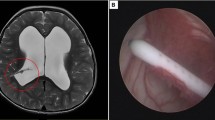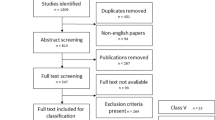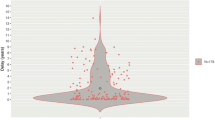Abstract
Background
Shunt placement for cerebrospinal fluid (CSF) diversion is one of the most commonly performed procedures in neurosurgery. Pleasure or sports diving is a popular sport enjoyed by millions. At present, no guidelines exist to affirm the safety of diving in the presence of a CSF shunt.
Methods
Literature search and review of medical fitness regulations used by diving organisations.
Results
Although the available evidence is anecdotal, no reports of shunt-related complications exist and in vitro studies show lasting functionality.
Conclusions
Patients with CSF shunts should undergo careful evaluation including assessment of their cognitive and physical needs as well as co-morbidities. Having a CSF shunt in situ is not in itself a contraindication to SCUBA diving.
Similar content being viewed by others
References
Aschoff A, Kremer P, Benesch C, Fruh K, Klank A, Kunze S (1995) Overdrainage and shunt technology. A critical comparison of programmable, hydrostatic and variable-resistance valves and flow-reducing devices. Childs Nerv Syst 11:193–202
Blount JP, Severson M, Atkins V, Tubbs RS, Smyth MD, Wellons JC, Grabb PA, Oakes WJ (2004) Sports and pediatric cerebrospinal fluid shunts: who can play? Neurosurgery 54:1190–1198
Bourgeois M, Sainte-Rose C, Cinalli G, Maixner W, Malucci C, Zerah M, Pierre-Kahn A, Renier D, Hoppe-Hirsch E, Aicardi J (1999) Epilepsy in children with shunted hydrocephalus. J Neurosurg 90:274–281
British Sub-Aqua Club webpage http://www.bsac.com. Accessed 17 Nov 2015
Chari A, Czosnyka M, Richards HK, Pickard JD, Czosnyka ZH (2014) Hydrocephalus shunt technology: 20 years of experience from the Cambridge Shunt Evaluation Laboratory. J Neurosurg 120:697–707
Cheng JF, Diamond M (2005) SCUBA diving for individuals with disabilities. Am J Phys Med Rehabil 84:369–375
Copeland GP, Foy PM, Shaw MD (1982) The incidence of epilepsy after ventricular shunting operations. Surg Neurol 17:279–281
Cumming B, Peddie C, Watson J. A review of the nature of diving in the United Kingdom and of diving fatalities in the period 1st Jan 1998 to 31st Dec 2009. British Sub-Aqua Club http://www.bsac.com/core/core_picker/download.asp?id=20349. Accessed 17 November 2015
Dan NG, Wade MJ (1986) The incidence of epilepsy after ventricular shunting procedures. J Neurosurg 65:19–21
Dayton P, Feilmeier M, Sedberry S (2013) Does postoperative showering or bathing of a surgical site increase the incidence of infection? A systematic review of the literature. J Foot Ankle Surg 52:612–614
Diaz JH, Lopez FA (2015) Skin, soft tissue and systemic bacterial infections following aquatic injuries and exposures. Am J Med Sci 349:269–275
Drake JM, da Silva MC, Rutka JT (1993) Functional obstruction of an antisiphon device by raised tissue capsule pressure. Neurosurgery 32:137–139
Huang ET, Hardy KR, Stubbs JM, Lowe RA, Thom SR (2000) Ventriculo-peritoneal shunt performance under hyperbaric conditions. Undersea Hyper Med 27:191–194
Jenkinson MD, Gamble C, Hartley J, Hickey H, Hughes D, Blundell M, Griffiths MJ, Solomon T, Mallucci CL (2014) The British antibiotic and silver-impregnated catheters for ventriculoperitoneal shunts multi-centre randomised controlled trial (the BASICS trial): study protocol. Trials 15:4
Newton HB (2001) Neurological complications of scuba diving. Am Fam Physician 63:2211–2218
Paulsen AH, Lundar T, Lindegaard KF (2015) Pediatric hydrocephalus: 40-year outcomes in 128 hydrocephalic patients treated with shunts during childhood. Assessment of surgical outcome, work participation, and health-related quality of life. J Neurosurg Pediatr 16:633–641
Paulsen AH, Lundar T, Lindegaard KF (2010) Twenty-year outcome in young adults with childhood hydrocephalus: assessment of surgical outcome, work participation, and health-related quality of life. J Neurosurg Pediatr 6:527–535
Preuss M, Kutscher A, Wachowiak R, Merkenschlager A, Bernhard MK, Reiss-Zimmermann M, Meixensberger J, Nestler U (2015) Adult long-term outcome of patients after congenital hydrocephalus shunt therapy. Childs Nerv Syst 31:49–56
Professional Association of Diving Instructors webpage http://www.padi.com. Accessed 17 Nov 2015
Singer AJ, Clark RA (1999) Cutaneous wound healing. N Engl J Med 341:738–746
The Sub-Aqua Association webpage http://www.saa.org.uk. Accessed 17 Nov 2015
Toon CD, Sinha S, Davidson BR, Gurusamy KS (2015) Early versus delayed post-operative bathing or showering to prevent wound complications. Cochrane Database Syst Rev 7:CD010075
Vinchon M, Baroncini M, Delestret I (2012) Adult outcome of pediatric hydrocephalus. Childs Nerv Syst 28:847–854
Contributors
All authors contributed to the conception of this work, participated in writing the manuscript, and provided approval of the submitted manuscript. All authors agree to be accountable for all aspects of the work in ensuring that questions related to the accuracy or integrity of any part of the work are appropriately investigated and resolved.
Author information
Authors and Affiliations
Corresponding author
Ethics declarations
Ethical standards
This article does not contain any studies with human participants or animals performed by any of the authors.
Conflict of interest
The authors declare that they have no conflict of interest.
Source of support
No funding was involved in preparation of this article.
Disclaimers
The views expressed in the article are the authors’ own. Not presented at conferences.
Rights and permissions
About this article
Cite this article
Shastin, D., Zaben, M. & Leach, P. Can patients with a CSF shunt SCUBA dive?. Acta Neurochir 158, 1269–1272 (2016). https://doi.org/10.1007/s00701-016-2800-x
Received:
Accepted:
Published:
Issue Date:
DOI: https://doi.org/10.1007/s00701-016-2800-x




